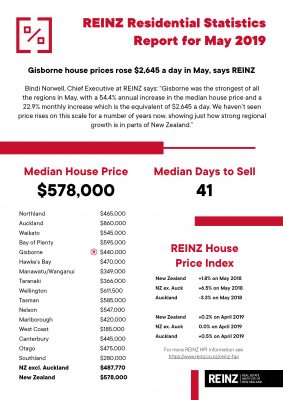From time to time we are asked why real estate statistics, and in particular the statistics released monthly by the Real Estate Institute of NZ (REINZ) refer to ‘median sale prices’ rather than ‘average sale prices’. The REINZ is the source of the most complete and accurate real estate data so to help clarify this point, let us quote the reasoning behind this as stated by the REINZ, themselves.
“Calculating REINZ statistics, median or average? Why the median is right for house price trends! There are technical reasons why the median provides a more accurate picture of what is happening to the prices of houses rather than the “average.” As an example, assume there are 11 houses sold in a month with a price range of $200,000 to $300,000 and an average price of $250,000. Now replace one of those houses with a house sold for $1million. The average is now $318,182 even though 10 of the 11 houses sold for less than this value. The median would be the price of the middle house sold in the range (in this case the sixth house), which more accurately reflects what the majority of the houses sold for. REINZ uses medians to provide a more accurate measure of the “mid-point” of house prices that reflects what most people are going to be buying and selling houses for.”
Having now clarified this reasoning, we quote from the latest press release from the REINZ, “The latest statistics released by the Real Estate Institute of New Zealand indicate that median house prices across New Zealand increased by 3.2% in May to $578,000; up from $560,000 in May 2018. Median price increases for New Zealand excluding the Auckland region were even stronger, increasing by 7.2% to $487,770 up from $455,000 in May last year.”
Principal and manager of Tommy’s Hutt Valley franchise, Mark Coffey, is also the Wellington District Regional Director of the REINZ; he reports specifically on Wellington’s May real estate sales statistics as follows, “The Wellington region’s median price was up 5.4% on the same time last year to $611,500 and the Kapiti Coast District median price exceeded the $600,000 mark for the first time with a record median price of $602,000 up from the previous record set in April of $580,000.” He also reports buyers are taking their time to purchase, which is why we are seeing a 24.1% increase in the number of days to sell, rising 7 days year on year.
So what can we take from these sale trends and our own observations of market statistics?
1. Apart from the obvious benefits of homeownership providing living stability, a safe and secure family environment and an opportunity to acquire capital gains over a period of time, real estate still offers real benefits for property investors. With median prices increasing steadily we believe that the advantages of a mid- to the long-term capital return and the security of investing in residential real estate outweighs other safe investments offered by the banks and similar institutions.
2. Recent sales trends show a move from the main centres to provincial New Zealand has gained in popularity. In support of this reasoning, demand in Gisborne has resulted in significant price increases in early 2019, Whanganui has welcomed increased housing activity and, as mentioned earlier in this article, the Kapiti Coast median prices have achieved new highs. The Kapiti Coast must surely become even more popular with Transmission Gully making the coast more accessible from Wellington City. Waikato and the Poverty Bay areas are growing rapidly with many Aucklander’s moving south.
3. The sale of inner city apartments was once dominated by property investors but that has changed somewhat. As well as ‘empty nesters’, more and more first home buyers are seeking inner-city accommodation as an alternative to the traditional ‘quarter acre section’, which is often beyond their means. There are also the advantages of less commuting time, access to inner city entertainment and elimination of travel costs, all of which enhance the popularity of inner city living.
4. With the vast increase in city house prices in recent years, we are also seeing numbers of homeowners selling and either buying smaller (perhaps an apartment) or moving to provincial New Zealand for purely economic reasons. Many see this as an opportunity to lessen their workload and at the same time supplement their bank balance with disposable income for those retirement years.
5. Retirement Villages have experienced considerable growth and popularity in recent years and moving to this living option is popular not only for health reasons but also to provide companionship and again, to release capital for those who are ‘equity rich but cash poor’.
In summary, for a variety of reasons there continues to be a high level of housing activity in and around Wellington City. Some of the market drivers we have mentioned above, but Wellington retains its popularity as a destination for other reasons such as for educational and career development opportunities. Tommy’s feels confident with the positive Wellington market trends that are evident, and we invite you to discuss with us in confidence how Tommy’s can assist you to participate in any way that may enhance your living and financial position.
Buying, selling or renting, we look forward to being of assistance.

